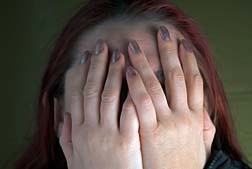You just need to see the pictures, to understand why...
SJS is an allergic reaction that affects the mucous membranes and the skin, and can become so severe it could threaten your life.
It can begin innocently enough, as a non-specific upper respiratory tract infection, characterized by fever, a sore throat, chills, headache, and lethargy. Vomiting and diarrhea are sometimes present in the early stages, but not often. In contrast, a fever is present in 85 per cent of the cases.
 The dark sides of SJS, however, are the skin lesions and Stevens Johnson Syndrome rash that can develop, which could lead to the sloughing, or loss of skin. It is this injury to the skin that is considered the most serious aspect of SJS, and is the characteristic of the disease that can, and has, resulted in death.
The dark sides of SJS, however, are the skin lesions and Stevens Johnson Syndrome rash that can develop, which could lead to the sloughing, or loss of skin. It is this injury to the skin that is considered the most serious aspect of SJS, and is the characteristic of the disease that can, and has, resulted in death.True we tend to take our skin for granted. But all you need do is read the horror stories of burn victims, and how close they had come to death as a result of suffering burns (an injury) to a vast expanse, if not the majority of their skin, to really appreciate the issue.
At worst, a victim of severe SJS could easily be confused with a burn victim to the uninformed; such are the dramatic lesions, the horrid sores, and the unspeakable shedding of skin that can come off in sheets.
Worst of all, this person has not gone through the unspeakable drama of a fire.
They simply popped a pill or drank a spoonful of syrup for something.
In recent years the US Food and Drug Administration (FDA) has taken steps to restrict drugs thought to have a specific link to SJS. In one example, the FDA removed a painkiller designed to ease the discomfort of rheumatoid arthritis from the US market in 2005. Bextra, manufactured by Pfizer, was soon gone from Canada and the European Union in the same fashion.
Other drugs have been linked to SJS, and regulatory authorities are taking these risks very seriously—especially considering the potential for mis-diagnosis for SJS, and the sheer numbers of patients taking many of these prescription, and over-the-counter drugs.
In late November of 2007, health officials called for stronger warnings for Provigil, a drug used for the treatment of narcolepsy—a sleep disorder. Manufactured by Cephalon, Provigil is their flagship drug and biggest performer, with global sales hitting US $415 million for the first half of 2007 alone.
While the proposed upgrade to the warning label addresses the issues of Provigil use for children (the drug is not approved to teat children under 16), the fact remains that Provigil has been linked to SJS.
Another recent development is the suspicion that Carbamazepine, which is marketed as Carbatrol, Equetro, Tegretol and various other generics designed to treat epilepsy and bipolar disorder, may have a greater negative impact on patients of Asian decent. An FDA communique released in mid-December of 2007 notes that SJS and the related Toxic Epidermal Necrolysis (TEN) skin conditions are significantly more common in patients with a particular leukocyte antifen (HLA) allele. HLA-B*1502 occurs "almost exclusively in patients with ancestry across broad areas of Asia, including South Asian Indians," according to an FDA fact sheet. Other sources note that SJS and TEN risk to Asians is ten times the levels of risk inherent with Caucasian patients.
It has been noted that incident rates of SJS in men outweigh women by a ratio of 2:1.
Here are some other unsettling statistics: of those who are extremely allergic to drugs such as Bextra and Arava, together with other painkillers and antibiotics, the majority of patients diagnosed with SJS are between the ages of 20 and 40. However, SJS has been diagnosed in patients as young as three months old.
One needs only to imagine the rash, the blisters, the oozing sores and the potential for infection, to consider the moral crime for anyone made to suffer in this way, let alone a child.
READ MORE LEGAL NEWS
Even if the onset of SJS is minor, the fact that the lips, inside the mouth and throat are a common host for lesions and blisters, suggests that patients can have extreme difficulty ingesting food and fluids, with difficulty eating, drinking and swallowing. This could result in weight loss, malnutrition and dehydration.
It has been reported that upwards of 100,000 patients die each year in the US from various allergic reactions to medications. It remains one of the highest causes of death in the country.
And Stevens-Johnson Syndrome is a most horrid way to go.
